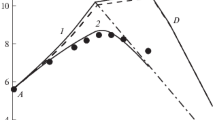Abstract
The results of investigating the heat from the explosion of individual and aluminized blasting compounds shows that, when testing an unconfined charges, the explosion’s products undergo intense secondary heating when they reach the wall of the calorimetric bomb’s inner cavity. Due to the secondary heating in the products, the chemical reactions are resumed, and the final composition of the products is frozen in conditions of slow cooling and low pressure. The inert metal casing in which a charge is placed attenuates the secondary heating since a significant part of the energy of the products is converted into the kinetic energy of the casing. The effect of filling a calorimetric bomb with an inert gas is similar to the action of a metal casing. In this case, the secondary heating temperature decreases due to the heat spent on heating the inert gas. When testing aluminized compositions, we need to use a heavy casing and fill the bomb with an inert gas (under pressure) in order to reduce the temperature of the secondary heating. The heat of explosion (HE) obtained under conditions when the secondary heating temperature does not reach the threshold value can be considered as a universal parameter that characterizes the energy content of an explosive material.





Similar content being viewed by others
REFERENCES
D. L. Ornellas, J. H. Carpenter, and S. R. Gunn, Rev. Sci. Instrum. 37, 907 (1966).
D. L. Ornellas, J. Phys. Chem. 72, 2390 (1968).
D. L. Ornellas, Combust. Flame 23, 37 (1974).
M. N. Makhov and V. I. Pepekin, in Chemical Physics of Combustion and Explosion Processes. Detonation (OIKhF AN SSSR, Chernogolovka, 1989), p. 23 [in Russian].
M. N. Makhov, Khim. Fiz. 19 (6), 52 (2000).
D. R. Hardesty and J. E. Kennedy, Combust. Flame 28, 45 (1977).
M. N. Makhov and V. I. Arkhipov, Russ. J. Phys. Chem. B 2, 602 (2008).
H. Hornberg, Propell. Explos. Pyrotech. 11, 23 (1986).
V. M. Titov, V. F. Anisichkin, and I. Yu. Mal’kov, Fiz. Goreniya Vzryva 25 (3), 117 (1989).
M. N. Makhov, in Proceedings of the 33rd International Annual Conference of ICT (Fraunhofer Inst. Chem. Technol., Pfinztal, 2002), p. 73.
J. S. Deiter and G. B. Wilmot, in Proceedings of the 10th International Symposium on Detonation, ONR 33395-12 (Office of Naval Res., Arlington, 1993), p. 619.
S. D. Gilev and V. F. Anisichkin, Fiz. Goreniya Vzryva 42 (1), 120 (2006).
Funding
This study was by a subsidy by the Semenov Federal Research Center for Chemical Physics of the Russian Academy of Sciences for the implementation of a state assignment on the topic “Creation of high-energy materials of a new generation and research of their characteristics” (state registration number AAAA-A18-118031490034-6).
Author information
Authors and Affiliations
Corresponding author
Additional information
Translated by V. Selikhanovich
Rights and permissions
About this article
Cite this article
Makhov, M.N. Determination of the Heat of an Explosion of Aluminized Blasting Compounds. Russ. J. Phys. Chem. B 14, 821–828 (2020). https://doi.org/10.1134/S1990793120050085
Received:
Revised:
Accepted:
Published:
Issue Date:
DOI: https://doi.org/10.1134/S1990793120050085




